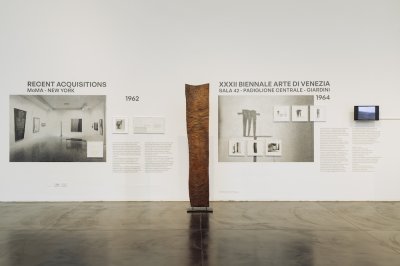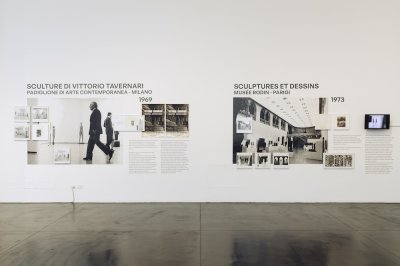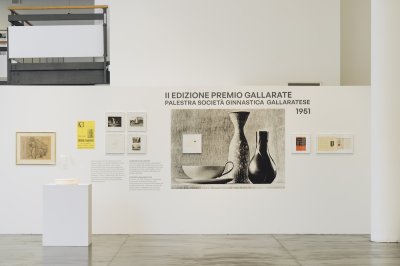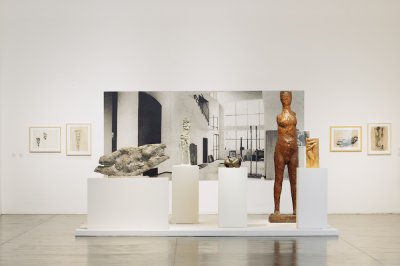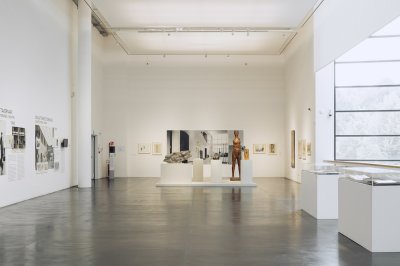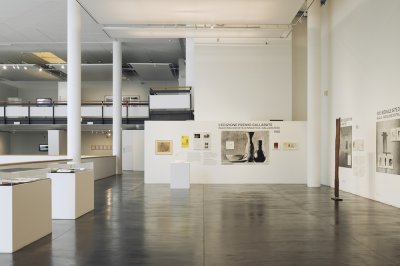Vittorio Tavernari. Vorrei scolpire l'universo
From 28th April
 28 April 2024–01 September 2024
28 April 2024–01 September 2024
The Exhibition
Vittorio Tavernari. I would like to sculpt the universe
Curated by Emma Zanella and Alessandro Castiglioni
28.04 - 01.09.2024
The exhibition presents the Museum's recent acquisition of Vittorio Tavernari's Archive, Library and a number of important works, obtained thanks to funding from the Ministry of Culture's General Directorate for Contemporary Creativity through the PAC - Plan for Contemporary Art 2023 call.
The exhibition is part of the exhibition programme of Italia 2050, Research Centre for Italian Art 1950-2050, founded by MA*GA in 2023.
The desire to valorise the heritage of one of the most significant Italian sculptors of the 20th century led to the project to acquire a very precious corpus, since April 2024 conserved in the MA*GA's storerooms, consisting of autographed letters, photographs and photographic plates, the catalogue of the artist's works and complete bibliography, his personal library, as well as a precious collection of works that the artist always kept for himself. The letters and publications include some of the most prestigious voices in Italian criticism, including Francesco Arcangeli, Carlo Ludovico Ragghianti, Marco Valsecchi and Mario De Micheli.
The exhibition, whose title Vorrei scolpire l'universo (I would like to sculpt the universe ) traces that of an article written by Tavernari himself in the magazine 'Epoca' in 1951, proposes works and documents from the Archive that explore some of the national and international initiatives in which the artist participated as a leading figure, bringing his language into dialogue with the dynamics and cultural transformations of his era.
The exhibition opens with a reference to two significant episodes for the city of Gallarate: Tavernari's participation in the second edition of the National Visual Arts Award of the City of Gallarate in 1951 and the creation of the Piazza Libertà Fountain, sculpted by the artist in direct cut in 1955.
A section analyses his experience between 1962 and 1963 at the MOMA in New York, where he exhibited his 1961 Torso, a large sculpture acquired for the permanent collections of the New York museum, alongside works by Frank Stella, Daniel Spoerri, Laszlo Moholy-Nagy and Joan Miró.
The following year, in 1963, Tavernari was invited by Luigi Carluccio to the XXXII International Art Biennale in Venice with a solo room of 11 sculptures.
A decade later, in 1972, the artist participated in the X Quadriennale in Rome and in the travelling exhibition Contemporary Italian Sculpture curated by the same Quadriennale, hosted by institutions such as theHanoke Open Air museum in Japan, the Museum of Modern Art in Mexico City, the Alten Museum in Berlin and the National Art Gallery in Athens.
In 1973, Tavernari was at the Musée Rodin in Paris with a large solo exhibition, curated by Monique Laurent, which definitively consecrated the sculptor on the European art scene. The exhibition consisted of 131 works including sculptures, watercolours and drawings, tracing the evolution of his investigation from the early 1950s to the end of the 1960s.
In his critical text published in the catalogue, Raymond Cogniat repeatedly emphasises how Tavernari continually investigated the passage from formlessness to form and vice versa, in an incessant search for the primary. From the first, more figurative works, Tavernari moved towards the creation of true prehistoric forms, columns and pillars, caves and ancestral ravines, capable of laying bare, through the expressionism inherent in the material - wood, stone, bronze, plaster - shaped by the artist.
The Artist
Vittorio Tavernari (Milan, 1919 - Varese, 1987) is one of the most important fathers of post-World War II Italian artistic culture, founder with Birolli, Morlotti, Guttuso and Testori of the magazine 'Numero' and signatory, in March 1946, of the famous Manifesto of Realism, commonly referred to as 'Beyond Guernica', a central document in the history of Italian art in the post-World War II period. His exhibition history and critical success was extensive. In 1964, after several participations, he had a solo room at the XXXII Venice Biennale. In 1969, a large solo exhibition was hosted by the PAC in Milan and 1973 the prestigious anthological exhibition at the Rodin Museum in Paris. He took part in numerous group exhibitions, including those at the MoMA in New York, the Hanoke Open Air museum in Japan, the Museum of Modern Art in Mexico City, the Alten Museum in Berlin and the National Gallery in Athens. His sculptures can be found in important museum collections, including MA*GA in Gallarate, Mambo in Bologna, Peggy Guggenheim Collection, Venice; Musei Vaticani, Vatican City. He died in Varese in 1987.

